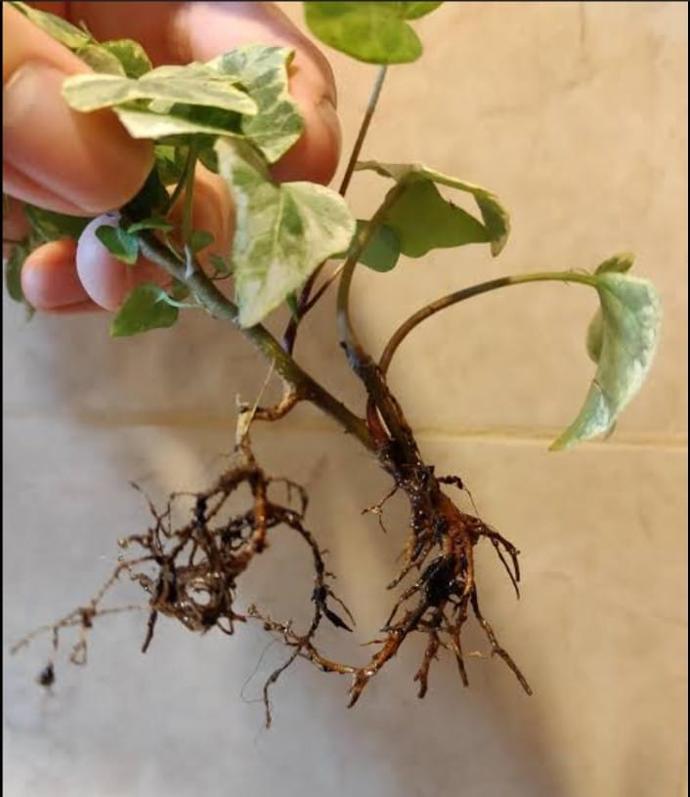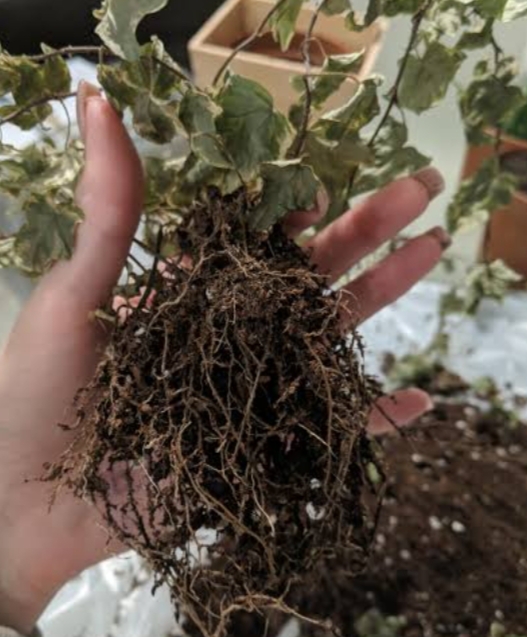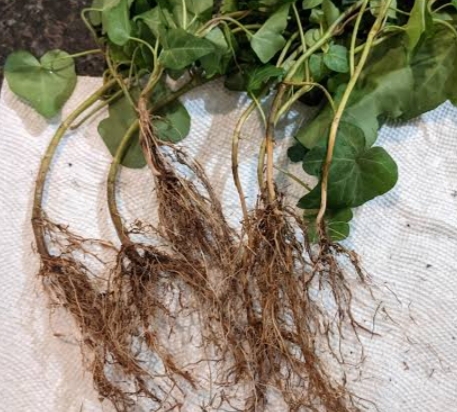English Ivy Hanging Plant
English Ivy Hanging, or Hedera helix, is a versatile trailing plant. Plant in well-draining soil and provide bright, indirect light. Allow the soil to partially dry between waterings. Prune to control its growth and maintain a tidy appearance. Suitable for hanging baskets.
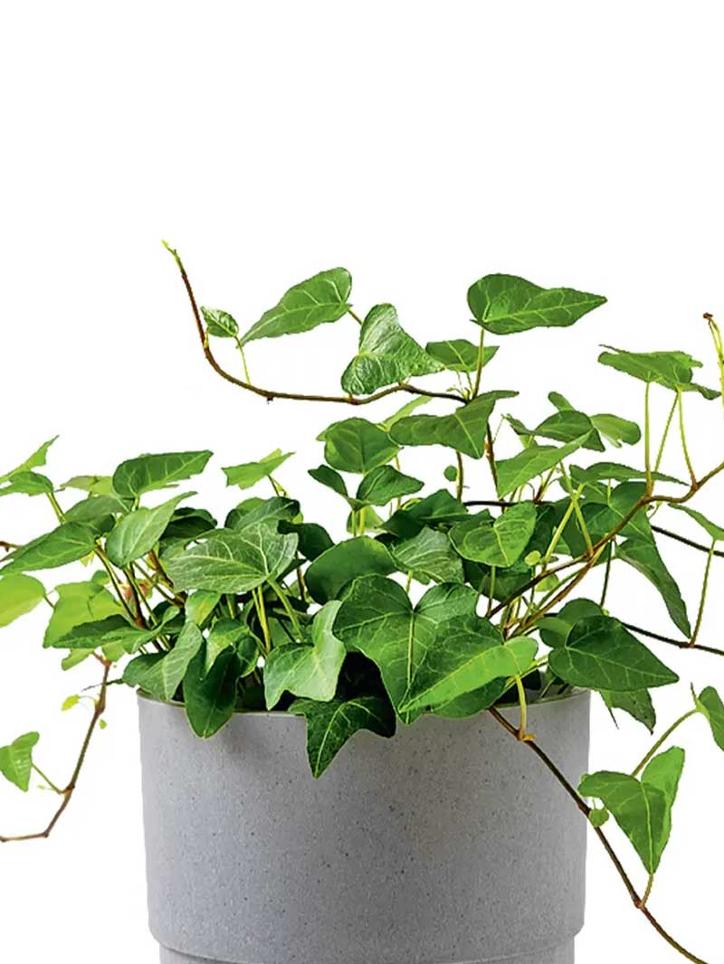
Habit
Climber
Height
1-3 m
Growth
Moderate
Soil
Well Drained, Loamy
Shade
Indirect light to shade
Moisture
Moist
Edible
No
Medicinal
No
Origin
Europe
Climatic Condition
Temperate
Temperature (°)
10-20°C
Humidity (%)
50-60%
Potting media
Peat-based mix
Fertilizers
Balanced fertilizer
Watering
Water regularly; tolerates dry soil once established
Plant Weight
0.2-0.5 kg
Flowering Time
Year-round
Soil Ph level
6.0 - 7.0
Water Ph level
6.0 - 7.0
Soil EC
0.3 - 0.5
Yield Per Plant
Ornamental use
NPK ratio
10:10:10
life Span
Perennial
Health Benefits
Common ornamental vine; air purification
Suggested Grow Media or Potting Mix ?
50% loamy soil, 30% compost, 20% sand
Suggested Fertigation/Fertilizers
Fertilize every 4 weeks with a balanced fertilizer.
Common Diseases and Remedies
Anthracnose, Leaf spot, Root rot
Leaves turn yellow and brown and water soaked lesions are formed on the leaves
Over irrigation should be avoided . use well draining potting mix, for good drainage .
HEALTH BENEFITS
· Known for respiratory benefits—helps with coughs, bronchitis, and asthma.
· Contains saponins, which act as natural expectorants. Has antimicrobial properties beneficial for skin conditions.
What Is An English Ivy Hanging Plant?
An English ivy hanging plant is a type of houseplant featuring trailing vines with small, pointed leaves. English ivy (Hedera helix) is popular for its ability to cascade elegantly from hanging baskets or to climb up structures when given support. It's prized for its lush, green foliage and is commonly used as a decorative element indoors or outdoors in gardens and landscapes.
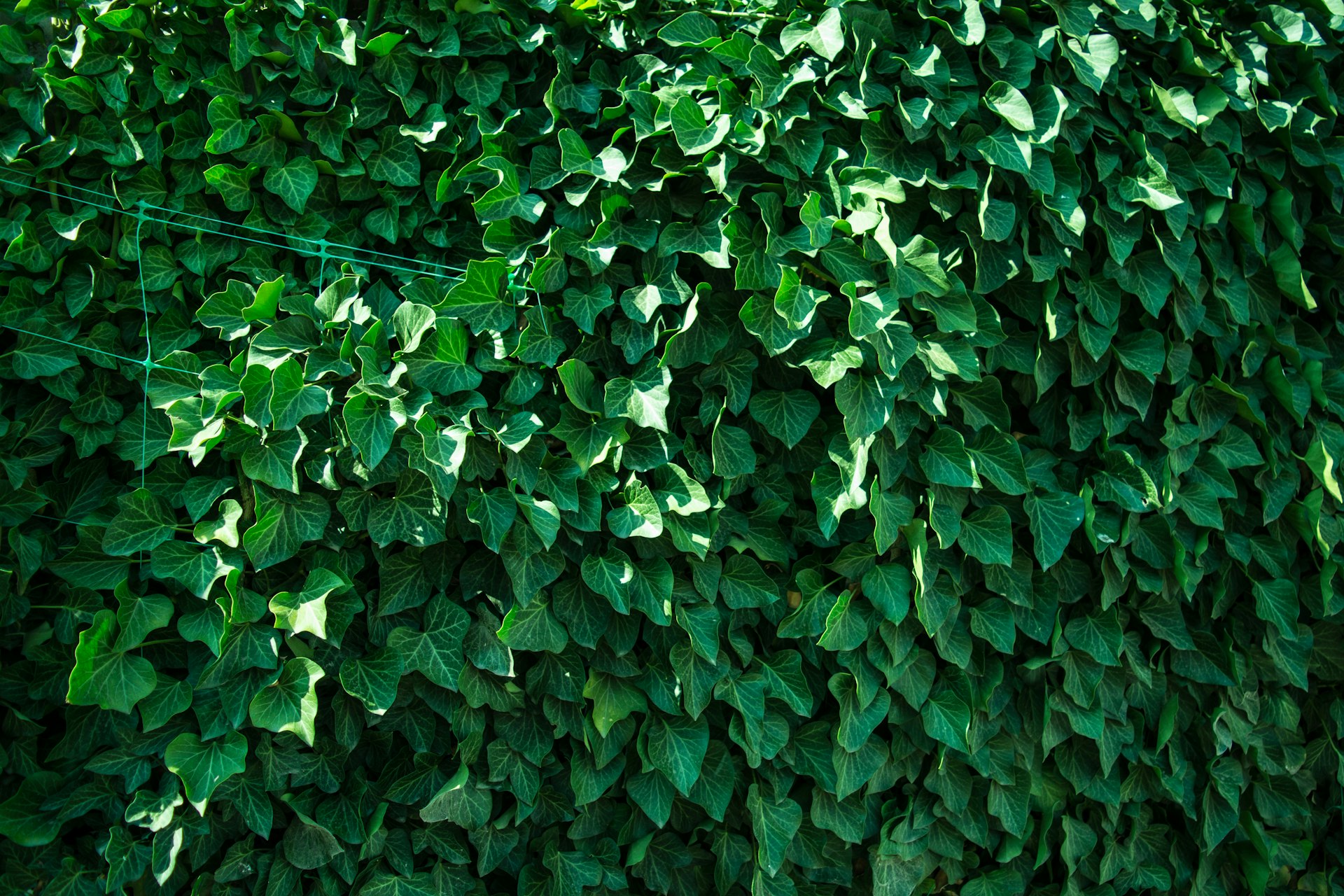
What are the different types of English ivy hanging plant?
There are several varieties of English ivy hanging plants, each with its own unique characteristics. Here are a few common types:
1. 'Hedera helix' (English Ivy):-
This is the standard English ivy variety, known for its classic dark green leaves and vigorous trailing growth. It's versatile and adaptable, making it suitable for various environments.
2. Hedera helix 'Golden Pothos' (Golden Ivy):-
This variety features leaves with variegated patterns of green and yellow, adding a bright and vibrant touch to any space. It shares similar growth habits with traditional English ivy.
3. 'Hedera helix 'Needlepoint' (Needlepoint Ivy):-
Needlepoint ivy has smaller, more delicate leaves compared to the standard English ivy. Its foliage is finely pointed, giving it a distinctive appearance. This variety is often used for more intricate and detailed arrangements.
4. Hedera helix 'Baltic' (Baltic Ivy):-
Baltic ivy is known for its larger, glossy leaves and vigorous growth habit. It's particularly well-suited for covering large areas or walls due to its robust nature.
5. 'Hedera helix 'Curly Locks' (Curly Locks Ivy):-
This unique variety of English ivy features leaves with ruffled or curled edges, adding texture and interest to its appearance. It's a popular choice for adding a whimsical touch to hanging baskets or container gardens.

How to care for English ivy hanging plant?
1.Location:
English ivy hanging plants can thrive in various locations, both indoors and outdoors, depending on the climate and lighting conditions. Here's a brief explanation of suitable locations.
2.Sunshine:
English ivy hanging plants prefer bright, indirect sunlight indoors and partial to full shade outdoors. Place your English ivy hanging plant near a window where it can receive bright, indirect sunlight. Direct sunlight can scorch the leaves, so it's essential to provide filtered light to prevent damage while still allowing the plant to photosynthesize effectively. In outdoor settings, English ivy thrives in partial to full shade. Morning sunlight is generally preferable, but it should be shielded from intense afternoon sun to prevent leaf burn. Planting it under trees or in shaded areas of the garden helps mimic its natural habitat and promotes healthy growth.
3.Soil:
Use a high-quality potting mix designed for indoor plants. Look for a mix that contains ingredients like peat moss, perlite, or vermiculite to ensure good drainage while retaining moisture. In outdoor settings, English ivy grows well in various soil types, including loamy, sandy, or clay soils, as long as they are well-draining. However, adding organic matter such as compost or aged manure can improve soil structure and moisture retention.
4.Hydration:
English ivy hanging plants require consistent but moderate hydration to thrive. Water your English ivy hanging plant when the top inch of the soil feels dry to the touch. Use room temperature water and thoroughly saturate the soil, allowing excess water to drain away freely from the pot's drainage holes. Avoid overwatering, as soggy soil can lead to root rot. In outdoor settings, monitor the moisture levels in the soil regularly, especially during hot and dry periods. Water deeply and evenly, ensuring that the soil around the root zone remains consistently moist but not waterlogged.

5.Nourishment:
Nourishing your English ivy hanging plant with appropriate fertilization helps promote healthy growth and vibrant foliage. Use a balanced liquid fertilizer formulated for houseplants or foliage plants. Look for a fertilizer with an equal ratio of nitrogen, phosphorus, and potassium (e.g., 10-10-10) to provide essential nutrients for overall plant health.Feed your English ivy hanging plant with diluted fertilizer every 4-6 weeks during the growing season, which typically spans from spring to early fall. Reduce or eliminate fertilization during the dormant winter months when growth slows down.Dilute the liquid fertilizer to half or quarter strength according to the manufacturer's instructions to avoid over-fertilization, which can cause salt buildup and damage the plant's roots. Apply the diluted fertilizer solution to the soil around the root zone, ensuring even distribution.
6.Issues:
English ivy hanging plants may encounter several issues, including pests, diseases, and environmental stressors. English ivy is susceptible to pests such as spider mites, aphids, and mealybugs. These pests can infest the foliage, causing damage and reducing plant vigor. Treat infestations promptly with insecticidal soap or neem oil. Common diseases affecting English ivy include powdery mildew, leaf spot, and root rot. Powdery mildew appears as a white, powdery coating on the leaves, while leaf spot causes dark spots or lesions. Ensure good air circulation, avoid overhead watering, and promptly remove and dispose of infected plant material to prevent the spread of disease. Excessive moisture in the soil can lead to root rot, characterized by wilting, yellowing leaves, and mushy roots. Allow the soil to dry out slightly between waterings and ensure proper drainage.
What are the benefits of the English ivy hanging plant?
English ivy hanging plants offer several benefits, both aesthetic and practical.
Air Purification
Versatile Decoration
Space Optimization

FAQS about growing English ivy hanging plant
1.How much sunlight does English ivy need?
English ivy hanging plants prefer indirect or filtered sunlight. They can tolerate low light conditions, but they will thrive best in bright, indirect light. Avoid placing them in direct sunlight for extended periods, as this can cause their leaves to scorch.
2.What kind of soil is best for English ivy hanging plant?
English ivy hanging plants prefer well-draining soil that is rich in organic matter. A general-purpose potting mix works well for them. You can also add perlite or sand to improve drainage. Ensure the soil is moist but not waterlogged, as English ivy doesn't like to sit in water.
3.How often should I water English ivy hanging plant?
English ivy hanging plants prefer to be kept consistently moist but not waterlogged. Allow the top inch of soil to dry out slightly between waterings, and then water thoroughly until water drains out of the bottom of the pot. Typically, watering once a week should suffice, but this may vary depending on factors such as temperature, humidity, and the type of potting mix used. Adjust your watering frequency accordingly to keep the soil evenly moist.
4.Can English ivy tolerate indoor conditions?
Yes, English ivy can tolerate indoor conditions quite well. It is often grown as a houseplant due to its ability to adapt to low light levels and indoor temperatures. Just ensure that it receives enough indirect sunlight and that its soil is kept consistently moist but not waterlogged. Additionally, providing occasional misting can help replicate the higher humidity levels that English ivy enjoys.
5.How do I propagate English ivy hanging plant?
English ivy can be propagated through stem cuttings. Here's how to do it:
Take a healthy stem cutting from an established English ivy plant. The cutting should be around 4-6 inches long and include several leaves. Remove the leaves from the bottom 2 inches of the cutting. Dip the cut end of the stem into rooting hormone powder to encourage root growth (optional but can improve success rates). Plant the cutting in a small pot filled with moistened potting mix. Make a hole in the soil with a pencil or your finger and insert the cutting, then gently firm the soil around it. Place the pot in a warm, bright location with indirect sunlight. Keep the soil consistently moist, but avoid overwatering. After a few weeks, roots should begin to develop. You can gently tug on the cutting to check for resistance, which indicates that roots have formed.
